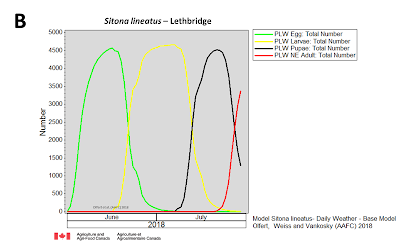 |
| Figure 1. Predicted pea leaf weevil phenology at Saskatoon (A) and Lethbridge (B). Values are based on model simulations for the current growing season (April 1 – July 30, 2018). |
Pea leaf weevil larvae develop under the soil over a period of 30 to 60 days. They are “C” shaped with a dark brown head capsule. The rest of the body is a milky-white color (Fig. 2 A). Larvae develop through five instar stages. In the 5th instar, larvae range in length from 3.5 - 5.5 mm. First instar larvae bury into the soil after hatching, and search out root nodules on field pea and faba bean plants. Larvae enter and consume the microbial contents of the root nodules (Fig. 2 B). These root nodules are responsible for nitrogen-fixation, thus pea leaf weevil larval feeding can affect plant yield and the plant’s ability to input nitrogen into the soil.
 |
| Figure 2. Pea leaf weevil larva in soil (A) and field pea root nodules damaged by larval feeding (B). Photos: L. Dosdall). |
Also refer to the pea leaf weevil page within the "Field Crop and Forage Pests and their Natural Enemies in Western Canada: Identification and management field guide" - both English-enhanced or French-enhanced versions are available. A review of this insect was published in 2011 in Prairie Soils and Crops by Carcamo and Vankosky.
